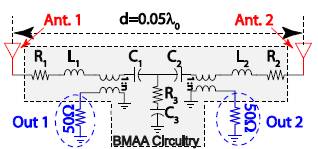Information Technology

Electrically-Small, Super-Resolving Antennas and Arrays
WARF: P110043US01
Inventors: Nader Behdad, Mudar Al-Joumayly
The Wisconsin Alumni Research Foundation (WARF) is seeking commercial partners interested in developing a small-scale electromagnetic antenna array capable of achieving high resolution with directional sensitivity.
Overview
The rise of wireless technology use in daily life has increased the need for electrically-small antennas with performance levels that exceed conventional limits. An electrically-small antenna is an antenna which is small in size relative to the desired wavelength. Directionality, or the ability to sense which direction a signal is coming from, is ideal because it enhances the capabilities of a small antenna.
Currently, achieving super-directivity from electrically-small antenna arrays is a challenge. Studies examining the relationship between the electrical dimensions of an antenna and its radiation characteristics have shown that a set of limitations exists that governs the performance of electrically small antennas and arrays. Although theoretically possible, existing technology for small antennas does not provide the ability of directional sensitivity. A need exists for a small antenna design that provides high resolution and super-resolving capabilities.
Currently, achieving super-directivity from electrically-small antenna arrays is a challenge. Studies examining the relationship between the electrical dimensions of an antenna and its radiation characteristics have shown that a set of limitations exists that governs the performance of electrically small antennas and arrays. Although theoretically possible, existing technology for small antennas does not provide the ability of directional sensitivity. A need exists for a small antenna design that provides high resolution and super-resolving capabilities.
The Invention
UW–Madison researchers have developed a small-scale electromagnetic antenna array capable of resolving the direction of arrival of an electromagnetic wave using principles based in nature. The design is based on directional hearing in insects that have two ears with minimal space between them. These insects use small differences in the time of arrival of sound between their two ears and amplify these minute differences to detectable levels.
This electrically-small antenna array design is a second-order coupled resonator network that includes two antenna inputs and two outputs. The design allows directional sensitivity by increasing the small phase difference between the almost-identical input signals. This allows the sensitivity pattern of the small array to become significantly more directional than that of a regular receiving array occupying the same area. Achieving the same sensitivity and output phases from regular arrays is only possible if the array size is increased and more antenna elements are used, making this an ideal design for small antenna arrays.
This electrically-small antenna array design is a second-order coupled resonator network that includes two antenna inputs and two outputs. The design allows directional sensitivity by increasing the small phase difference between the almost-identical input signals. This allows the sensitivity pattern of the small array to become significantly more directional than that of a regular receiving array occupying the same area. Achieving the same sensitivity and output phases from regular arrays is only possible if the array size is increased and more antenna elements are used, making this an ideal design for small antenna arrays.
Applications
- Communication systems
- Small-aperture radar systems
- Devices to assist disabled persons
- Medical imaging systems
- Homeland security applications
- Sensors
- Microwave/mm-wave imaging systems
- Other applications suitable for small arrays at various frequencies
Key Benefits
- Resolves direction of arrival of electromagnetic waves with the precision of significantly larger antennas
- Decreases cost of antenna design
- Allows applications not currently possible due to space constraints
Stage of Development
The development of this technology was supported by WARF Accelerator. WARF Accelerator selects WARF's most commercially promising technologies and provides expert assistance and funding to enable achievement of commercially significant milestones. WARF believes that these technologies are especially attractive opportunities for licensing.
Additional Information
Related Technologies
For current licensing status, please contact Michael Carey at [javascript protected email address] or 608-960-9867
Figures
